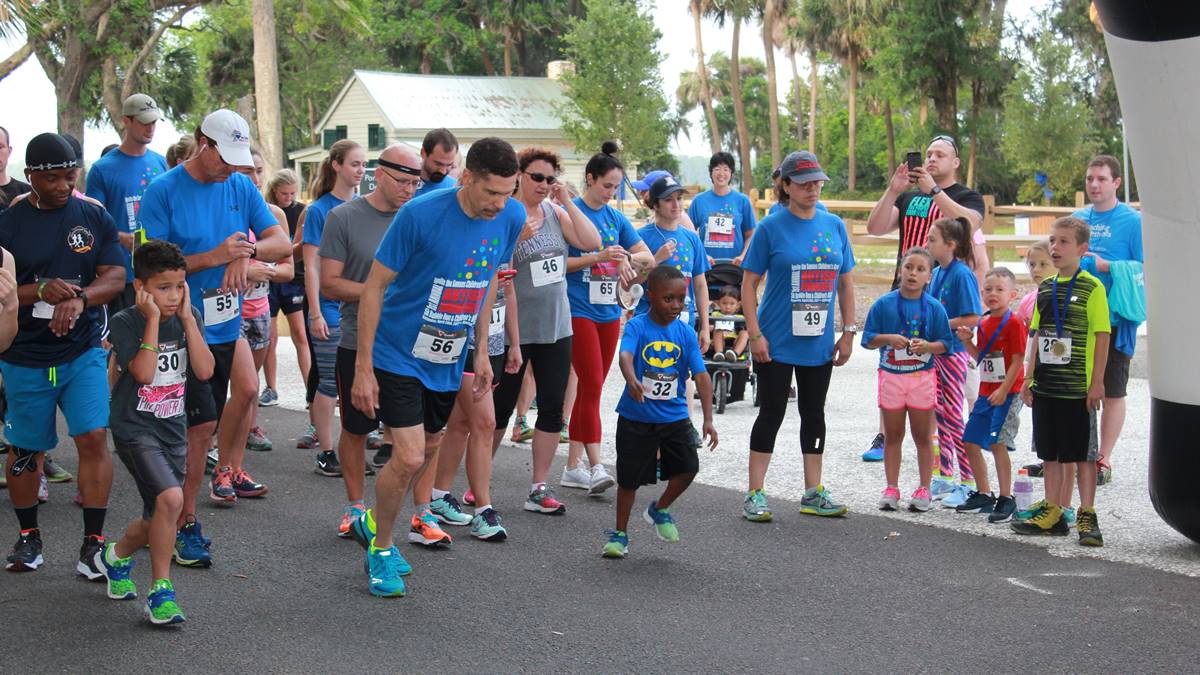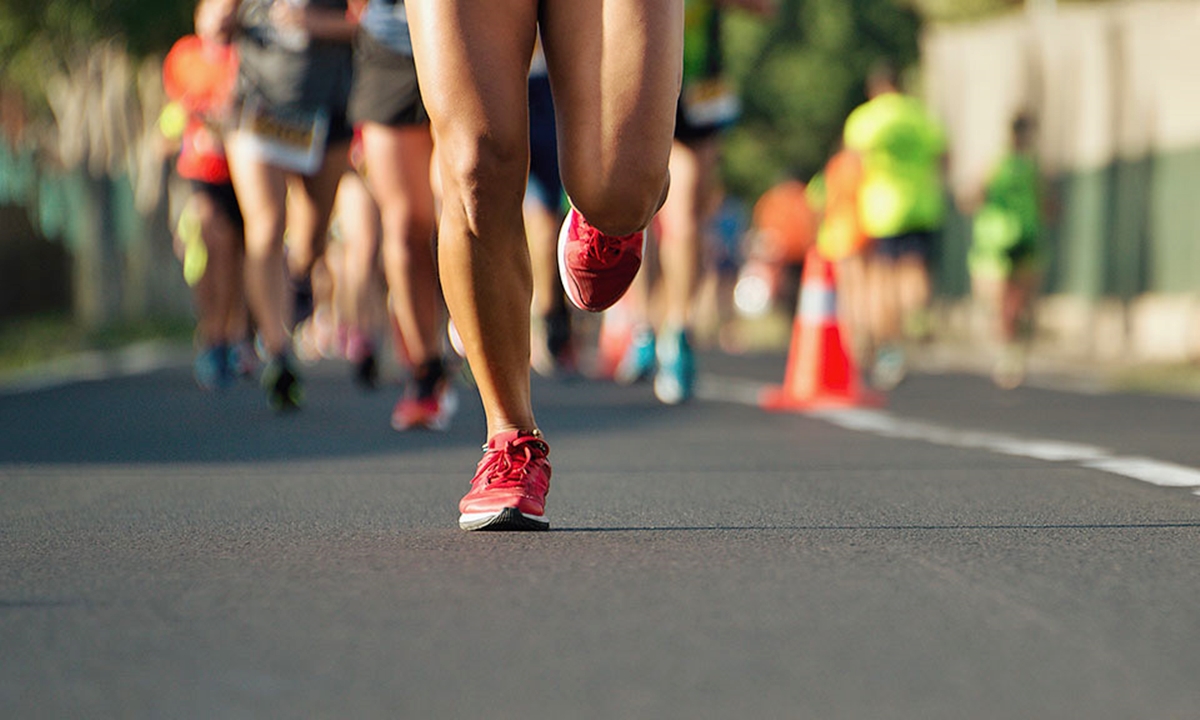

Featured
How To Do A 5K Run
Modified: October 24, 2023
Learn how to do a 5K run with our featured guide, providing step-by-step instructions and tips to help you reach your running goals.
Introduction
Welcome to the world of 5K runs! Whether you’re a seasoned runner looking for a new challenge or a beginner eager to take your first steps into the running world, the 5K distance is a great place to start. A 5K run, which measures approximately 3.1 miles, is an achievable goal for many individuals and provides an excellent opportunity to improve your fitness level, set personal records, and participate in exciting running events.
In this article, we will guide you through the ins and outs of completing a successful 5K run. We will cover everything from setting your goal and preparing for the run to running techniques, pacing, hydration, and recovery. By incorporating these tips into your training, you can optimize your performance and have a fulfilling experience on race day.
Running a 5K requires commitment, perseverance, and some essential knowledge to ensure your success. Whether you’re aiming to achieve a specific time goal or simply want to complete the distance, this article will provide you with the guidance you need to make the most out of your 5K journey.
So, lace up your running shoes, stretch those muscles, and let’s dive into the fascinating world of 5K runs and discover how to achieve your personal best!
Setting Your Goal
Before you embark on your 5K journey, it’s crucial to define your goal. Setting a clear and achievable objective will help guide your training and keep you motivated throughout the process. Here are a few factors to consider when setting your 5K goal:
- Finish Time: Determine the time you want to complete your 5K run in. Whether you’re aiming for a personal best or simply want to finish the race, having a specific time goal in mind will help structure your training regimen.
- Consistency: Consider how many days per week you can commit to training. This will help you gauge how much time you have to prepare for your 5K and establish a realistic training plan.
- Previous Experience: Take into account your current fitness level and any previous running experience. If you’ve never run a 5K before, setting a goal to simply finish the race can be a great starting point. On the other hand, if you have a solid running background, you may aim to beat your previous 5K record.
- Motivation: Find a source of motivation that will keep you focused on your goal. Whether it’s running for a cause, competing with friends, or improving your overall fitness, having a compelling reason to participate in the 5K will drive you to stay committed to your training.
Once you’ve established your goal, write it down and keep it somewhere visible. This will remind you of your purpose and serve as a constant reminder to stay motivated. Remember, setting a realistic and attainable goal will help you stay committed and enjoy the journey leading up to your 5K run.
Preparing for the Run
Preparing for your 5K run goes beyond just lacing up your running shoes. It involves a combination of physical and mental preparation to ensure you’re in the best possible shape for race day. Here are some essential steps to help you prepare:
- Get a Medical Clearance: Before starting any new exercise program, it’s important to consult with your doctor to ensure you’re in good health and able to participate in a 5K run.
- Invest in Proper Running Shoes: Visit a specialty running store to get fitted for a pair of running shoes that suit your foot type and running style. Wearing the right shoes will help prevent discomfort and reduce the risk of injuries.
- Design a Training Plan: Create a training plan that gradually increases your mileage and includes both running and cross-training activities. This will help build your endurance and improve your overall fitness level.
- Warm-up and Stretch: Prior to each training session, warm up with some light aerobic exercises and dynamic stretches to increase blood flow and loosen up your muscles. After your run, cool down with static stretches to help prevent stiffness and aid in recovery.
- Listen to Your Body: Pay attention to how your body responds to training. If you experience pain or discomfort, it’s important to rest and allow your body to recover. Pushing through injuries can lead to more serious issues.
- Build Mental Resilience: Running a 5K requires mental strength, especially during challenging moments. Practice positive self-talk, visualization techniques, and mental strategies to stay focused and motivated during your training sessions and the race itself.
In addition to these steps, consider joining a running group or finding a running buddy who can provide support and accountability. Surrounding yourself with like-minded individuals can make the journey more enjoyable and help you stay motivated.
Remember, preparation is key to a successful 5K run. Take the time to properly prepare your body and mind, and you’ll be well on your way to crossing that finish line with confidence!
Warming Up
A proper warm-up is essential before any physical activity, especially before a 5K run. Warming up helps prepare your body for the upcoming exercise by increasing blood flow to your muscles, enhancing flexibility, and mentally focusing your mind. Here are some key elements to include in your warm-up routine:
- Start with a Brisk Walk: Begin your warm-up by walking at a moderate pace for about 5-10 minutes. This gradually increases your heart rate and warms up your muscles.
- Dynamic Stretching: Perform a series of dynamic stretches that target the major muscles groups used in running, such as leg swings, walking lunges, and high knees. Dynamic stretching helps improve your range of motion and prepares your muscles for the specific movements involved in running.
- Activate Your Muscles: Include exercises that activate your core and glutes, such as plank variations and squats. These exercises help stabilize your body and improve your running posture.
- Do Some Strides: Strides are short bursts of faster running. Include a few sets of 50-100 meters at a pace slightly faster than your race pace. Strides help prime your muscles for speed and prepare your body for the intensity of the race.
- Mental Preparation: Use the warm-up period to mentally prepare yourself for the run. Visualize yourself running strong, staying focused, and crossing the finish line with confidence. Positive visualization can help boost your performance and mindset during the race.
It’s important to tailor your warm-up routine to your individual needs and preferences. Experiment with different exercises and stretches to find what works best for your body. Keep in mind that the purpose of a warm-up is to gradually increase your heart rate and warm up your muscles, not to exhaust yourself before the race.
Lastly, don’t skip your warm-up, even if you’re feeling pressed for time. A proper warm-up can help reduce the risk of injuries and improve your overall performance during the 5K run. Dedicate a few extra minutes to prepare your body and mind, and you’ll be ready to tackle the race ahead!
Running Techniques
Effective running techniques can make a significant difference in your 5K performance. By improving your form and adopting efficient running mechanics, you can maximize your speed and reduce the risk of injuries. Here are some key running techniques to incorporate into your training:
- Posture: Maintain a tall posture while running, with your head up, shoulders relaxed, and core engaged. Avoid slouching or leaning too far forward or backward, as it can strain your muscles and affect your breathing.
- Footstrike: Aim for a mid-foot or forefoot strike, where your foot lands directly under your body, rather than striking with the heel first. This helps distribute impact forces evenly and improves your running efficiency.
- Leg Cadence: Strive for a high leg turnover or cadence, aiming for around 180 steps per minute. Increasing your cadence can help you maintain a faster pace and reduce the risk of overstriding, which can lead to inefficient running and potential injuries.
- Arm Swing: Keep your arms relaxed and bent at a 90-degree angle. The movement of your arms should be forward and back, rather than side-to-side. Proper arm swing helps maintain balance and propels you forward.
- Breathing: Practice rhythmic breathing by inhaling and exhaling deeply. Find a breathing pattern that works for you, such as inhaling for two steps and exhaling for two steps, to help supply your muscles with oxygen and maintain a steady breathing rhythm.
- Head and Eye Position: Keep your head in a neutral position, looking straight ahead rather than at the ground. This helps maintain proper alignment of your spine and improves your overall running form.
It’s important to remember that adopting new running techniques may take time and practice. Start by focusing on one aspect at a time and gradually incorporate the others into your training. Consistency is key in developing and refining your running techniques, so be patient and persistent in your efforts.
Consider working with a running coach or joining a running clinic to receive guidance and feedback on your form. They can provide valuable insights and help you make adjustments to improve your running efficiency and prevent potential injuries.
By honing your running techniques, you’ll not only enhance your performance in the 5K, but also develop a more enjoyable and sustainable running experience overall.
Pace and Speed
Understanding pace and speed is crucial for successfully completing a 5K run. Pace refers to the time it takes to complete one mile or kilometer, while speed is the rate at which you cover a certain distance. To optimize your performance and achieve your goals, it’s important to find the right balance between pace and speed. Here’s how:
- Know Your Current Pace: Start by determining your current pace by timing yourself during a practice run or using a running app or GPS watch. This will give you a baseline to work from and help you set realistic targets.
- Train at Different Paces: Incorporate different types of runs into your training, including long, easy runs to build endurance, tempo runs to improve your lactate threshold, and interval runs to enhance speed and anaerobic capacity. Varying your pace during training helps your body adapt to different exertion levels and improves your overall race performance.
- Use a Negative Split Strategy: In a 5K race, a negative split strategy involves running the second half of the race faster than the first half. Start at a comfortable pace, then gradually increase your speed in the second half. This helps conserve energy and ensures you finish strong.
- Practice Race Pace: Incorporate specific workouts where you run at your goal race pace. This will help familiarize your body with the required effort level and build confidence in maintaining that pace during the actual race.
- Listen to Your Body: While it’s important to push yourself during training, listen to your body’s cues and avoid overexertion or pushing beyond your limits. If you’re feeling fatigued or experiencing pain, adjust your pace accordingly and prioritize rest and recovery.
- Stay Mindful of Effort Level: Instead of focusing solely on pace or speed, pay attention to your perceived rate of exertion. Keep tabs on your breathing, heart rate, and how comfortable you feel during your runs. Adjust your pace to maintain a challenging but sustainable effort level.
Remember, both pace and speed are personal and depend on factors like your fitness level, experience, and goals. Be patient with your progress and aim for gradual improvements over time. The key is finding a pace and speed that allows you to maintain consistency throughout the 5K race and finish strong.
By incorporating a strategic approach to pace and speed into your training, you’ll be better equipped to tackle the challenges of the 5K and achieve your desired results.
Hydration and Nutrition
Proper hydration and nutrition play a vital role in your performance and overall well-being during a 5K run. To ensure you have enough energy and stay hydrated throughout the race, consider the following tips:
- Hydration: Before the race, make sure to hydrate well by drinking water throughout the day leading up to the event. During the run, aim to take small sips of water at designated water stations or carry a handheld water bottle to stay hydrated. Adjust your fluid intake based on temperature and your individual sweat rate.
- Electrolytes: In addition to water, replenish electrolytes lost through sweating by consuming sports drinks or electrolyte-rich foods like bananas or oranges. Electrolytes help maintain proper muscle function and prevent dehydration.
- Prioritize Pre-race Nutrition: Consume a balanced meal containing carbohydrates, protein, and a small amount of healthy fats a few hours before the run. Opt for easily digestible foods like oatmeal, whole grain toast, or a smoothie. Avoid heavy or high-fiber foods that may cause digestive discomfort.
- During-race Fueling: For a 5K, fueling during the run may not be necessary. However, if you feel the need for an energy boost, consider consuming a small carbohydrate-rich snack like an energy gel or a few bites of a sports bar. Experiment with different options during your training to determine what works best for you.
- Post-run Recovery: After completing the 5K, prioritize replenishing your glycogen stores and aiding muscle repair by consuming a combination of carbohydrates and protein within 30 minutes of finishing the race. This can be a snack such as a banana with nut butter or a protein shake to kickstart the recovery process.
- Practice Nutrition Strategies: Use your training runs as an opportunity to practice your hydration and nutrition strategies. Experiment with different fluids, energy gels, or foods to see what works best for your body and doesn’t cause any digestive issues.
Everyone’s nutritional needs may vary, so it’s important to listen to your body and make adjustments accordingly. Pay attention to any signs of dehydration or inadequate fueling during your training runs, and use that feedback to fine-tune your hydration and nutrition plan for the 5K race.
Consulting with a sports nutritionist may also be beneficial, as they can provide personalized guidance based on your specific needs and goals.
Remember, proper hydration and nutrition are essential for optimizing your performance and enjoying a successful 5K run. Take the time to fuel your body appropriately, and you’ll feel the difference on race day!
Dealing with Challenges
Running a 5K can present various challenges along the way, both physical and mental. It’s important to be prepared and equipped with strategies to overcome these obstacles. Here are some common challenges runners may face and how to tackle them:
- Mental Fatigue: Running can be physically demanding, but it can also be mentally challenging. To combat mental fatigue, break the race into smaller segments or landmarks, focusing on one section at a time. Use visualization techniques, positive self-talk, or distractions like music or podcasts to keep your mind engaged.
- Physical Discomfort: It’s normal to experience physical discomfort during a 5K, whether it’s muscle soreness, blisters, or fatigue. Prepare for this by training in similar conditions and wearing comfortable, well-fitting running gear. Consider using blister prevention products or applying Vaseline in areas prone to chafing.
- Hills or Elevation: If your 5K course includes hills or takes place at a higher elevation than you’re accustomed to, incorporate hill training into your workouts. Focus on maintaining good form and adjusting your pace accordingly. Practice uphill and downhill running techniques to optimize your efficiency.
- Weather Conditions: Running in extreme heat, cold, or rain can present a unique set of challenges. Stay hydrated in hot weather, dress in layers for colder temperatures, and consider wearing moisture-wicking clothing to stay dry in the rain. Listen to your body and adjust your pace or shorten your run if conditions become unsafe.
- Race Day Nerves: Pre-race jitters are normal, but they can have a negative impact on your performance if not managed properly. Develop a pre-race routine that helps you stay calm and focused. Practice deep breathing exercises or meditation to reduce anxiety. Surround yourself with supportive friends or family who can provide encouragement and reassurance.
- Setbacks and Settle-In Period: It’s normal to face setbacks during your 5K journey, such as missed training days or a plateau in performance. Be flexible and patient with yourself. Remember that progress is not always linear, and a few setbacks don’t define your overall success. Allow yourself time to settle into a consistent training routine and don’t be too hard on yourself.
Ultimately, the key to overcoming challenges is maintaining a positive mindset and embracing the journey. Embrace the process and focus on the improvements you’re making, rather than solely fixating on the end result. Stay persistent, adapt to the challenges that come your way, and celebrate your achievements along the route to your 5K finish line!
Post-Run Recovery
Post-run recovery is just as important as the run itself. Taking the time to properly recover after a 5K run helps prevent injuries, replenish energy stores, and promote muscle repair. Here are some key strategies to aid in your post-run recovery:
- Cool Down: After completing your 5K, take a few minutes to gradually decrease your heart rate and cool down. Slow your pace to a walk or gentle jog and incorporate some light stretching to help alleviate muscle tension.
- Hydrate: Replenish fluids lost during the run by drinking water or a sports drink. Aim to hydrate within 30 minutes of finishing the race to aid in rehydration and recovery.
- Eat a Balanced Meal: Consume a meal or snack containing carbohydrates and protein within one to two hours after your run. This will help replenish energy stores and aid in muscle recovery. Opt for whole foods like lean proteins, fruits, vegetables, and whole grains.
- Active Recovery: Engage in light, low-impact activities such as walking, swimming, or cycling on your recovery days. These activities promote blood flow, loosen up muscles, and facilitate the removal of metabolic waste products.
- Self-Care Techniques: Treat your body to some self-care techniques to aid in recovery. This may include foam rolling, using a massage ball or foam roller to release tight muscles, or taking an Epsom salt bath to relax and ease any muscle soreness.
- Get Enough Rest: Allow your body enough time to rest and recover between training sessions. This may involve incorporating rest days into your weekly schedule or adjusting your training intensity to prevent overtraining and minimize the risk of injury.
- Listen to Your Body: Pay attention to any signs of fatigue, pain, or discomfort. If your body is telling you it needs more rest or requires additional recovery time, listen and make adjustments to your training plan or seek professional advice if necessary.
Remember, recovery is a crucial part of your training process and helps set the foundation for future runs and improved performance. Prioritize rest, nourishment, and self-care to recover effectively and ensure your body is ready for your next training session or race.
By implementing these recovery strategies, you’ll be able to bounce back faster, reduce the risk of injury, and optimize your performance in future 5K runs.
Conclusion
Congratulations, you’ve reached the end of this comprehensive guide on how to prepare for and successfully complete a 5K run! By setting clear goals, preparing both physically and mentally, and implementing effective strategies, you’ll be well on your way to conquering the 5K distance and achieving your personal best.
Throughout this article, we’ve covered a range of topics, including goal-setting, warm-up routines, running techniques, pace and speed considerations, hydration and nutrition tips, dealing with challenges, and post-run recovery strategies. By incorporating these practices into your training, you can optimize your preparation and increase your chances of having a successful 5K experience.
Remember, everyone’s journey is unique. Don’t compare yourself to others and don’t be too hard on yourself during the process. Enjoy the thrill of progress and celebrate every milestone along the way, whether it’s running a little bit farther, improving your time, or simply crossing the finish line.
Lastly, always listen to your body. Rest when you need to, adjust your training program as necessary, and seek professional advice if you’re experiencing persistent pain or discomfort.
Now it’s time to lace up your running shoes, step out of your comfort zone, and embark on this exciting 5K adventure. Whether it’s your first or fiftieth 5K, remember to enjoy the journey, embrace the challenges, and savor the incredible feeling of accomplishment as you cross that finish line!








